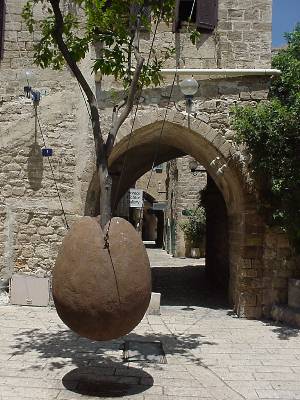 |
 |
 |
|
|
It shouldn't have surprised us, but it did, that nearly
everyone we've met here has a story, sometimes terrifying, of how they
arrived here, or how their parents arrived here. We've met people who were
in camps, or who were part of the Etzel (Irgun), the terrorist movement to
get the British out of Palestine, or who spent much of their childhood
running away from the Nazis in one country after another.
The Diaspora Museum, or Beth Hatefutsoth, chronicles the long story of the migration of Jews farther and farther from Israel over 2500 years after their expulsion by the Babylonians. The entry sign is a metaphor, welcoming Jews from all over the world to make aliyah, or return to Israel. |
| One hundred years ago, what is now Tel Aviv
only comprised a small area north of Jaffa, which was an Arab city. The
shortage of housing for Jews in Jaffa motivated Jews to build Neve Tzedek in
the latter part of the nineteenth century. It attracted intellectuals and
artists.
Today, this neighborhood is under redevelopment, and it still retains its artistic character. The streets are lined with busy cafés, shops and galleries. The residents have shown the same spirit in decorating their homes, such as this building festooned with dolls, some of whom appear to be hanging on for dear life. |
|
 |
Tel Aviv faces west into the Mediterranean, and Friday night at sunset, the beginning of the Sabbath, is a time to celebrate. At Chinky Beach, young people gather to watch the sun sink into the ocean. On a cliff alongside the water, people pound on drums, juggle flaming sticks, dance, toss Frisbees, or simply blow bubbles while wearing a pair of wings. |
| According to Jewish tradition, Jaffa was
founded by Noah's son, and archaeological evidence demonstrates that Jaffa
was a port at least 4000 years ago. Only about a hundred years ago, Tel Aviv
was nearly empty and Jaffa was important; now Jaffa is a suburb that has
been absorbed into the Tel Aviv municipality.
The old town is inside the city walls, many of which still exist despite the many times that Jaffa was conquered during its long history. Napoleon's armies took the town, and then all the soldiers died of cholera when the decaying bodies of the inhabitants poisoned the water supply. Now, the streets in the old town are named for astrological signs, galleries abound, and many craftspeople still work in studios there. This orange tree growing from a suspended orange is a reminder of the Jaffa oranges that are exported around the world. |
 |